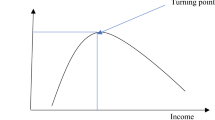Abstract
We use a Computable General Equilibrium model to simulate the effects of an Environmental Tax Reform in a regional economy (Andalusia, Spain). The reform involves imposing a tax on CO2 or SO2 emissions and reducing either the Income Tax or the payroll tax of employers to Social Security, and eventually keeping public deficit unchanged. This approach enables us to test the so-called double dividend hypothesis, which states that this kind of reform is likely to improve both environmental and non-environmental welfare. In the economy under analysis, an employment double dividend arises when the payroll tax is reduced and, if CO2 emissions are selected as environmental target, a (limited) strong double dividend could also be obtained. No double dividend appears when Income Tax is reduced to compensate the environmental tax.
Similar content being viewed by others
Author information
Authors and Affiliations
Corresponding author
Rights and permissions
About this article
Cite this article
André, F.J., Cardenete, M.A. & Velázquez, E. Performing an environmental tax reform in a regional economy. A computable general equilibrium approach. Ann Reg Sci 39, 375–392 (2005). https://doi.org/10.1007/s00168-005-0231-3
Issue Date:
DOI: https://doi.org/10.1007/s00168-005-0231-3




